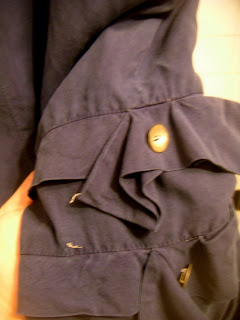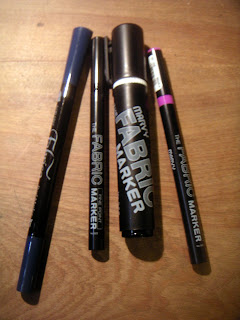Here is the promised guest post. Thank you Cindy. I just wish Jane had made these dresses in the colors you chose.
Over to Cindy:
Upon scanning the Mayle Spring 2008 lookbook, I swooned.
Mexican funeral!
Flowers everywhere!
After a second pass, I begin to feel pangs of dismay – the book was full of covetable pieces, mostly in ivory.
Frankly, I fear wearing all-white ensembles because I thoroughly enjoy eating and sitting.
Notwithstanding, I purchased the Adela dress and the Bibi dress, convinced I would wear these beautiful pieces bravely.
After languishing in my closet months later, tags and all, I decided to finally take the plunge and explore dyeing.
I fantasized about the dresses’ Franken-Mayle potential – how would ochre and plum silks look with enamel buttons?
I wrote to Ms. Mayle, seeking dyeing advice for my Spring 2008 ivory silks.
Would the dresses shrink?
How would they dye?
She wrote:
“Hi Cindy-
I know that the dresses are made from sand washed spun silk and that the silk was dyed before construction. I don’t think the dresses should shrink significantly when dyed but I’m not sure what the content is for the thread and I worry that it might be poly in which case, it wouldn’t dye with the rest of the dress, resulting in contrast color stitching.
All the best with your dyeing adventures!
Jane”
Based on the fact that I didn’t really understand most of Jane’s e-mail, I decided immediately that DIY was out of my league.
With a little googling, I learned that silk is a protein fiber that takes up dye beautifully.
The dyeing process varies depending on the type of silk and how the silk was pre-treated.
Dresses, however, are constructed with many other materials that are not dye-friendly – in particular, synthetic threads and linings, along with other un-dyeable details.
Mayle, fortunately, constructs most garments with silk linings, which eliminated the possibility that the lining would shrink disproportionately compared to the outer layer (positively horrifying).
During my internet searches, I only found a handful of places willing to do “individual garment” dyeing.
I chose Metro Dyeing for the following reasons: 1) they had a write-up in
New York Magazine; 2) the business was conveniently located in the Manhattan garment district; 3) the cost per dyed garment was $50; and 4) upon e-mailing, they agreed to let me unburden my dyeing neuroses in person.
Their website:
http://www.sampledyeingny.com/about.php
(They have a great “before and after” section where they feature Courtney Love’s dyed stage costumes.
Very reassuring!)
Craig, my friendly and helpful contact at Metro Dyeing, made me realize quickly that dyeing is not for the faint of heart.
The maximum shrinkage rate for a silk garment is approximately 4%.
If you’ve dry-cleaned the garment, the dye may settle unevenly.
The details on the dress would be affected by the agitation process.
The synthetic materials (like the bib on Bibi) would not dye the same color as the rest of the dress but would pick up some dye if there was some organic material in it (like the cotton in the bib).
Even color choice can be minefield – yellows and greens are unpredictable and require harsher dyeing processes and temperatures; purples and blues are easier.
Dyeing any garment black would require multiple passes and a true black was not guaranteed.
But there were plenty of positives – Craig and his team are fabric dyeing professionals and would work with me during the dyeing process until I got the color I required (at no extra charge!).
He told me that the dyes were safe for sensitive skin, would not be affected by dry cleaning, and ultimately, he reminded me that I wouldn’t wear the ivory pieces as much the dyed pieces.
I settled on a dusky purpley plum for Adela and a navy blue for Bibi.
Here are the intermediate results, post-work up, about three weeks after the first dye:
Upon viewing the dresses within the first 24 hours post-dye, I wished Craig hadn’t let me come up for a peek.
The results were terrifying.
The dresses felt like dried paper mache.
Most of the detailing – hems, straps, buttons - needed mending.
The synthetic threads and bib had taken up little or no dye.
But at least the dresses hadn’t shrunk much.
They had shrunk proportionately, perhaps by less than 2% total.
Craig suggested steaming the garments.
After about a week and two steamings, the sandwashed softness of the silk returned.
Encouraged, I searched for appropriate final touches for my dyed pieces.
To re-color the bib and obvious contrast threads, I turned to Dharma Trading Company (
http://www.dharmatrading.com/) and purchased colorfast, dry-cleaning safe fabric markers that didn’t require special “settings” (i.e., ironing).
I found mother-of-pearl and brass buttons to replace the original peach buttons on Adela (thank you, Moya!) and asked my tailor to replace the white zipper on the navy and black Bibi with a black zipper.
With mended hems and re-sewn details, button and zipper replacements, and painstakingly hand-colored contrast threading, here are the final results, almost two months after I sent my garments to Metro Dyeing:
Voila, that concludes my Franken-Mayleing!
I am very pleased with the final dresses and I have loved giving my personal touches to these pieces.
I hope you enjoy the pictures and find that this post encourages you to consider dyeing (with all kinds of caveats!).
I pass this along to you as Jane wrote to me, “All the best with your dyeing adventures!”































